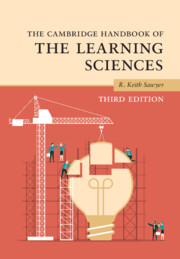Book contents
- The Cambridge Handbook of the Learning Sciences
- The Cambridge Handbook of the Learning Sciences
- Copyright page
- Contents
- Figures
- Tables
- Contributors
- Preface
- 1 An Introduction to the Learning Sciences
- Part I Foundations
- Part II Methodologies
- Part III Grounding Technology in the Learning Sciences
- Part IV Learning Together
- Part V Learning Disciplinary Knowledge
- 23 Research in Mathematics Education
- 24 Science Education and the Learning Sciences
- 25 Complex Systems and the Learning Sciences
- 26 Learning History
- 27 Learning to Be Literate
- 28 Arts Education and the Learning Sciences
- Part VI Moving Learning Sciences Research into the Classroom
- Index
- References
28 - Arts Education and the Learning Sciences
from Part V - Learning Disciplinary Knowledge
Published online by Cambridge University Press: 14 March 2022
- The Cambridge Handbook of the Learning Sciences
- The Cambridge Handbook of the Learning Sciences
- Copyright page
- Contents
- Figures
- Tables
- Contributors
- Preface
- 1 An Introduction to the Learning Sciences
- Part I Foundations
- Part II Methodologies
- Part III Grounding Technology in the Learning Sciences
- Part IV Learning Together
- Part V Learning Disciplinary Knowledge
- 23 Research in Mathematics Education
- 24 Science Education and the Learning Sciences
- 25 Complex Systems and the Learning Sciences
- 26 Learning History
- 27 Learning to Be Literate
- 28 Arts Education and the Learning Sciences
- Part VI Moving Learning Sciences Research into the Classroom
- Index
- References
Summary
Learning in the arts is distinct from most other subjects for three reasons. First, the arts are centrally a representational domain and learning in the arts involves becoming aware of how representational choices communicate meaning to different audiences. Second, form and meaning are integrated; artistic representations are saturated with meaning, and subtle variations are consequential to that meaning. Third, work in the arts involves examining identify and culture, because artistic cognition is intertwined with both. This chapter argues that these three distinct features of arts learning have implications for our understanding of learning more generally. The chapter reviews four types of research: (1) how the arts have been studied in educational settings; (2) how learning occurs in different arts including music and visual arts; (3) the key features of arts learning: the role of the audience, critique, authentic assessment, and role taking; (4) how an arts-based perspective can contribute to our understanding of learning in all subjects.
- Type
- Chapter
- Information
- The Cambridge Handbook of the Learning Sciences , pp. 560 - 578Publisher: Cambridge University PressPrint publication year: 2022

